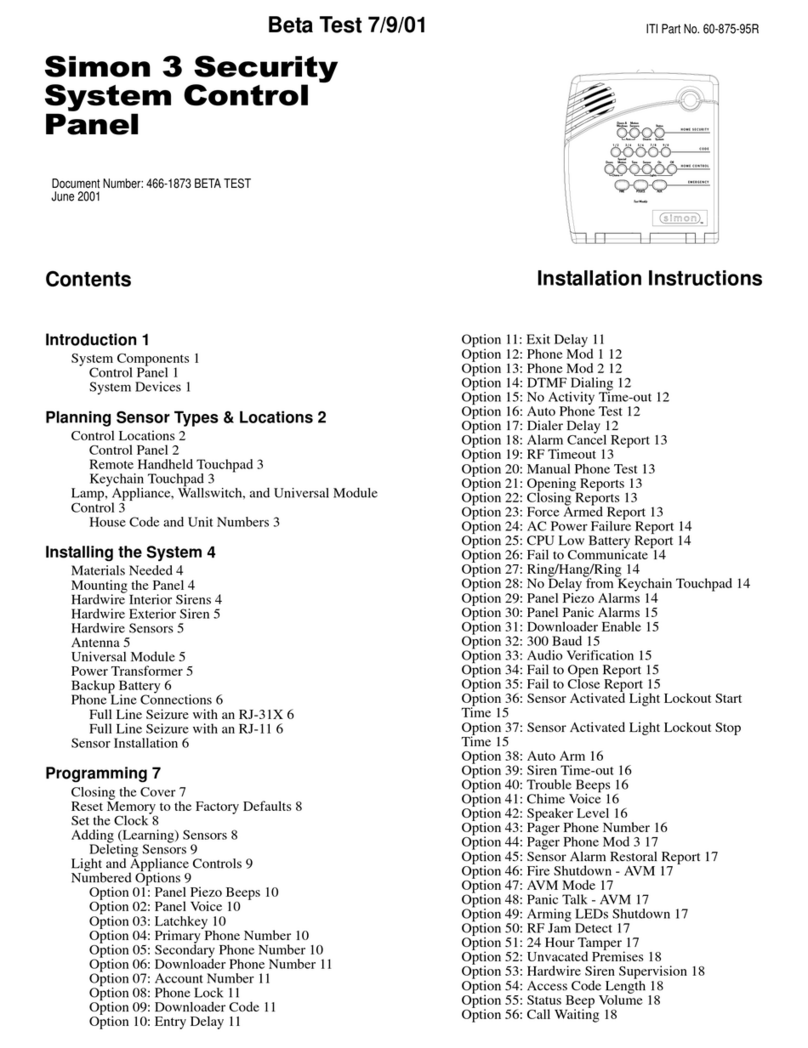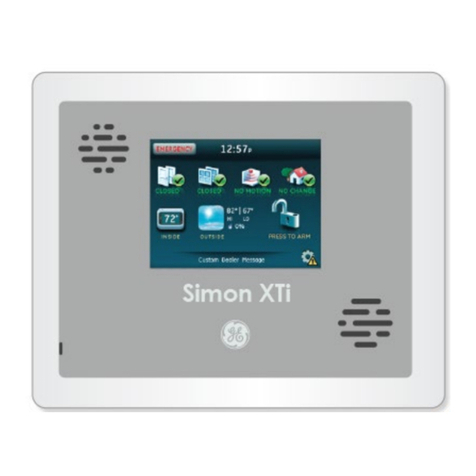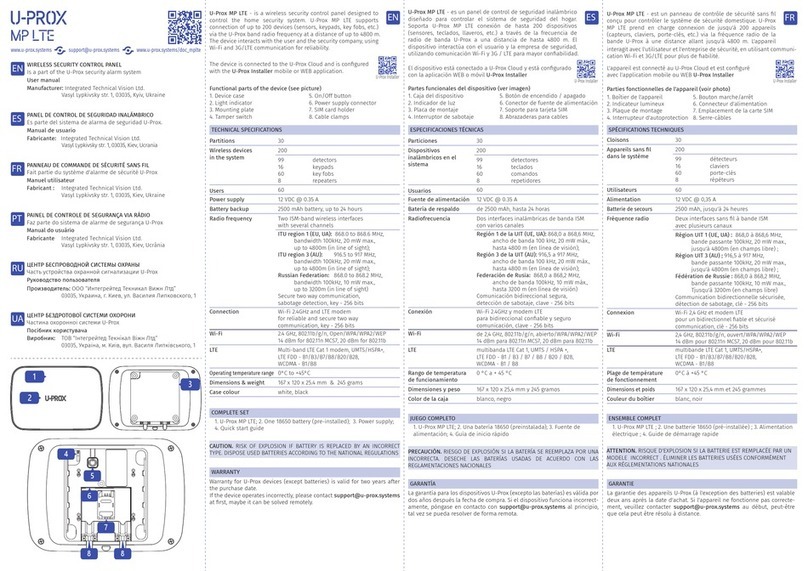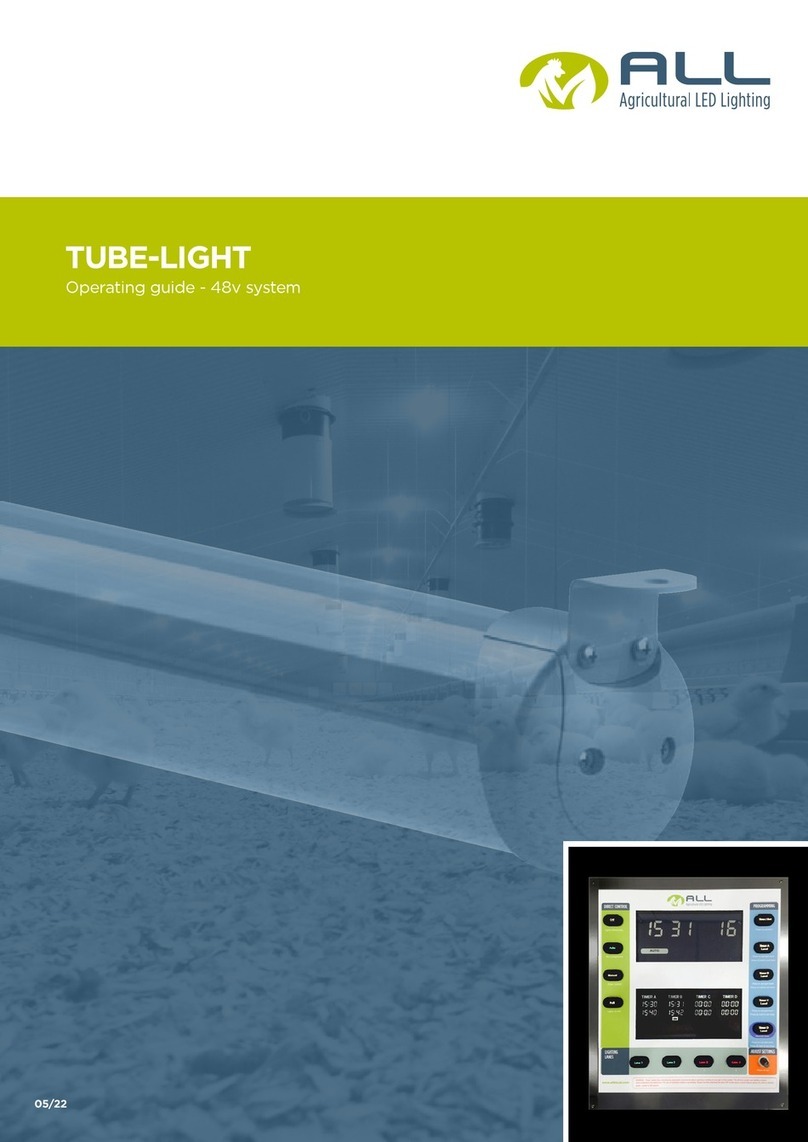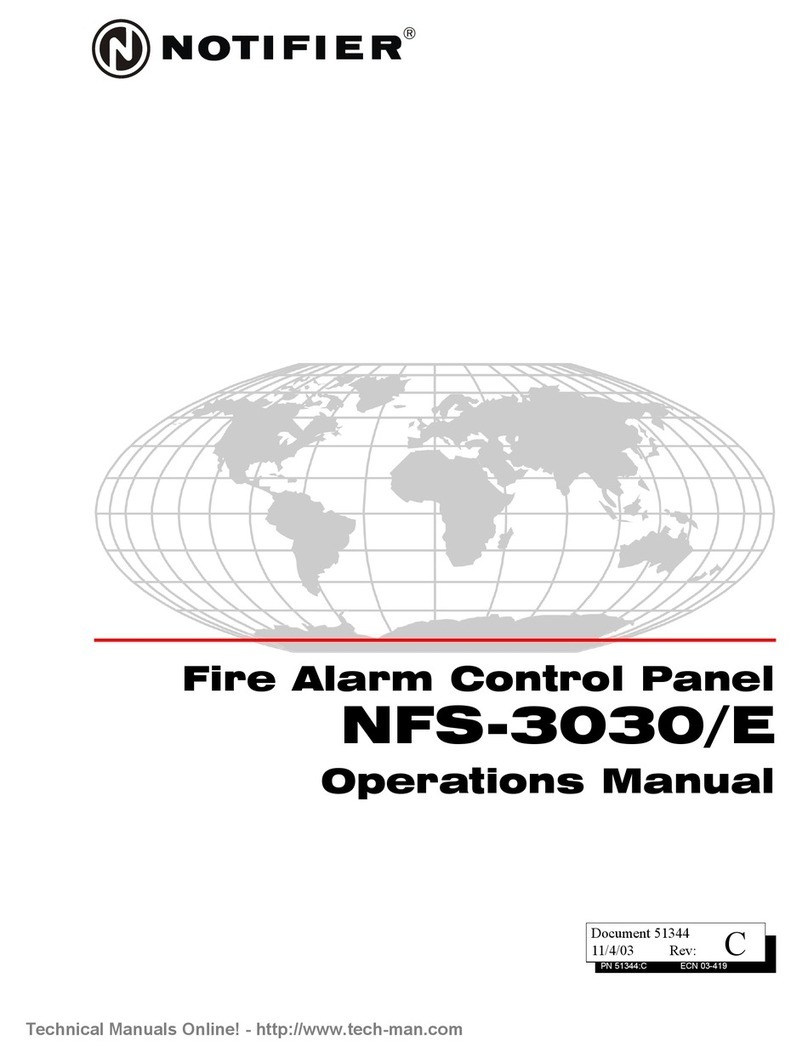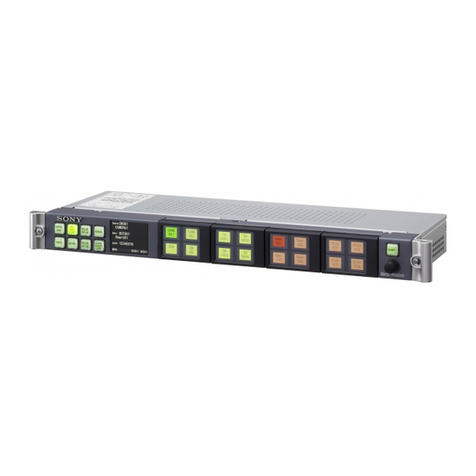Simon M-SHEV-10-AP User manual

BA_M-SHEV_EN_17 www.simon-protec.com Date: 30.07.2019
BA M-SHEV-10-AP (ECO) M-SHEV-10 / -24 / -48 / -72 (ECO) EN 1.7
Operating manual
Modular control panel of the M-SHEV product family
Copyright by SIMON PROtec Systems GmbH
Subject to technical changes and errors. All figures are exemplary.
Only valid with the supplementary sheet: “Safety instructions and warranty conditions“!
Operating manualModular control panel of the M-SHEV product familyBA_M-SHEV_DE_161.7/07.2019BA M-SHEV-10-AP / M-SHEV DE 1.5
For further information please visit
our product website
short.simon-protec.com/msheven

BA_M-SHEV_EN_17 Date: 30.07.2019
Issue: 1.7/07.2019
Table of contents
Page 2
1. Preface ...............................................................................................................................................................4
1.1 Foreword to this manual ................................................................................................................................4
1.1.1 Validity of the manual ................................................................................................................................4
1.1.2 SIMON LINK ............................................................................................................................................4
1.1.3 SIMON PLUS ...........................................................................................................................................4
1.1.4 M-SHEV ECO ...........................................................................................................................................4
1.2 Use for the intended purpose ........................................................................................................................4
1.3 Functional description ...................................................................................................................................5
2. Components ......................................................................................................................................................6
2.1 Power supply ................................................................................................................................................6
2.1.1 Emergency power supply ........................................................................................................................... 7
2.1.2 Regulating the I/U charge ..........................................................................................................................7
2.1.3 Monitoring the monitor input for sequential control (mains/emergency operation) .............................................7
2.1.4 Technical data (rated values) .....................................................................................................................7
2.2 Fault mode ....................................................................................................................................................9
2.3 Internal BUS connection ...............................................................................................................................9
2.3.1 Terminal plugs AS-110 ..............................................................................................................................9
2.4 Central Interface – ZI-100 ...........................................................................................................................10
2.4.1 General functions .................................................................................................................................... 10
2.4.2 Ventilation ..............................................................................................................................................10
2.4.2.a Wind/rain detector (WTS) connection ................................................................................................10
2.4.3 Global ventilation button ..........................................................................................................................10
2.4.4 Digital inputs ...........................................................................................................................................10
2.4.5 Maintenance counter ...............................................................................................................................10
2.4.6 Technical data ZI-100 (-ZI1) ..................................................................................................................... 10
2.5 Sensor Interface – SI-100 ...........................................................................................................................11
2.5.1 Trigger or indicating lines (line monitored) ..................................................................................................11
2.5.2 Indicators ...............................................................................................................................................11
2.5.3 ALARM mode reset .................................................................................................................................11
2.5.4 DIP switches ..........................................................................................................................................11
2.5.5 Reset function ........................................................................................................................................11
2.5.6 Fire alarm system AUTORESET function ..................................................................................................12
2.5.7 Fault triggered only on power outage ........................................................................................................12
2.5.8 Fireman’s override switch / SI-100-MASTER ..............................................................................................12
2.5.9 SI-100-SP ..............................................................................................................................................12
2.5.10 Technical data SI-100 (-SI1) ................................................................................................................... 12
2.6 Motor Relay – MR-120 ...............................................................................................................................13
2.6.1 Triggering of the load relays (“S” and “O” terminals) ....................................................................................13
2.6.2 ALARM functions ....................................................................................................................................13
2.6.2.a Open delay in alarm mode ...............................................................................................................13
2.6.2.b Priority function (Basic) ....................................................................................................................13
2.6.2.c Priority function (Extended) ..............................................................................................................13
2.6.2.d Retriggering function (deadlock) .......................................................................................................14
2.6.2.e Alarm ONLY with analog input (optional) — Dependency logic .............................................................14
2.6.3 Ventilation functions ................................................................................................................................14
2.6.3.a Connection ventilation button/input ventilation signals .........................................................................14
2.6.3.b Action behaviour of ventilation buttons ............................................................................................... 14
2.6.3.c Open delay in vent mode .................................................................................................................14
2.6.3.d WTS (wind /rain-detector) .................................................................................................................14
2.6.3.e Gap ventilation ................................................................................................................................14

BA_M-SHEV_EN_17 Date: 30.07.2019
Issue: 1.7/07.2019 Page 3
Table of contents
2.6.3.f Automatic close ............................................................................................................................... 14
2.6.3.g Eco mode ....................................................................................................................................... 15
2.6.3.h Time until next thermostat query ....................................................................................................... 15
2.6.3.i Ventilation ONLY with analog input (optional) — Dependency logic ....................................................... 15
2.6.4 Analog input (optional) ............................................................................................................................ 15
2.6.5 Technical data MR-120 (-MR1) ................................................................................................................. 15
2.7 Message Interface – MI-100 (optional) ....................................................................................................... 16
2.7.1 Triggering the dry signal contacts ............................................................................................................. 16
2.7.2 Assigning parameters to the dry signal contacts ......................................................................................... 16
2.7.2.a Condition (logical operation) ............................................................................................................. 16
2.7.2.b Switching delay ............................................................................................................................... 17
2.7.2.c Hold time ........................................................................................................................................ 17
2.7.3 Technical data MI-100 (-MI1) ................................................................................................................... 17
2.8 BUS Interface – BI-100 (optional) ............................................................................................................... 18
2.8.1 MODBUS ............................................................................................................................................... 18
2.8.2 Digital inputs .......................................................................................................................................... 18
2.8.3 Technical data BI-100 (-BI1) .................................................................................................................... 18
3. Mechanical connection .................................................................................................................................. 19
3.1 M-SHEV-10-AP ........................................................................................................................................... 19
3.2 M-SHEV ...................................................................................................................................................... 19
4. Electrical connection ...................................................................................................................................... 20
4.1 230 V AC connection (-x1) .......................................................................................................................... 20
4.2 Central interface – ZI-100 ........................................................................................................................... 21
4.3 Sensor interface – SI-100 ........................................................................................................................... 21
4.4 Motor relay – MR-120 ................................................................................................................................. 22
4.4.1 Motor cable monitoring by DD-100 ............................................................................................................ 22
4.5 Message interface – MI-100 (optional) ....................................................................................................... 22
4.6 BUS interface – BI-100 (optional) ............................................................................................................... 22
5. Commissioning ................................................................................................................................................ 23
5.1 M-SHEV-10-AP ........................................................................................................................................... 23
5.2 M-SHEV ...................................................................................................................................................... 23
6. Appendix .......................................................................................................................................................... 24
6.1 Care and Maintenance ................................................................................................................................ 24
6.2 General business and delivery terms .......................................................................................................... 24
6.3 Company Addresses ................................................................................................................................... 24
7. Manufacturer's declaration ............................................................................................................................ 24
8. EC manufacturer’s declaration (distributor) ................................................................................................ 24

Preface
BA_M-SHEV_EN_17 www.simon-protec.com Date: 30.07.2019
info@simon-protec.com Issue: 1.7/07.2019
Page 4
Operating manual
1 Preface
1.1 Foreword to this manual
This manual is intended for professional operation, installation
and maintenance by trained, knowledgeable and qualified
personnel (such as mechatronics engineer or electrician) and/
or qualified personnel who know how to install electrical equip-
ment.
Read this operating manual carefully and pay particular atten-
tion to the hazard warnings. Store this operating manual for
future reference/maintenance. Please pay close attention to
the terminal assignment, the minimum and maximum perfor-
mance data (see “Technical Data”) and the installation instruc-
tions. Incorrect use or improper operation/mounting may
cause loss of system functionality and damage to property
and/or people.
The following symbols can be found in this manual:
Operating procedures are marked this way.
Consequences are presented this way.
•Buttons or switches to be pressed/activated are shown
in bold.
• “Indicators” are placed in quotation marks.
1.1.1 Validity of the manual
1.1.2 SIMON LINK
1.1.3 SIMON PLUS
1.1.4 M-SHEV ECO
1.2 Use for the intended purpose
The M-SHEV product family (Modular Smoke and Heat
Exhaust Ventilation) consists of electrical control devices in a
sheet steel housing with power supply, emergency power
supply and complete control and regulation electronics for the
operation of 24 V DC actuators.
Ventilation signals from
• ventilation buttons
• wind/rain detectors
and alarm triggering of three monitored indicating lines
• emergency button
(SHEV-emergency button)
•smoke/thermal detectors
• fire alarm control system (FAS)
can be processed.
The M-SHEV modular control units control actuators both in
the event of fire (as smoke and heat extraction systems) and
for daily ventilation. In the event of a power failure, the
emergency power supply ensures the function of the SHEV
system for at least 72 hours.
INFORMATION
An information text gives you additional hints!
ATTENTION
This warning notice alerts you to potential hazards that
may impact the product!
DANGER
This warning notice alerts you to potential hazards to your
life or health!
ENVIRONMENT NOTICE
This notice alerts you to potential environmental hazards!
INFORMATION
As of July 2019, this manual applies to M-SHEV control
systems with firmware version from mid 2019 and
SIMON LINK 2.2.0 or higher!
INFORMATION
Functions that can be configured or
enabled with SIMON LINK are marked
with the SIMON LINK logo!
You can find more information about
SIMON LINK on our website
short.simon-protec.com/slen
INFORMATION
SIMON PLUS are extra features, available at an additional
charge, which must be enabled ex works or on site by a
SIMON service technician.
For more information, please contact our technical sales
department.
INFORMATION
The here described factory configuration for control units
of the ECO product class cannot be changed via
SIMON LINK.
Status messages can be read out.

BA_M-SHEV_EN_17 www.simon-protec.com Date: 30.07.2019
Preface
1.3 Functional description
The control modules of the electrical control system M-SHEV
use bus technology to communicate with each other. In case
of an ALARM-trigger or during daily ventilation operations, the
M-SHEV controls the connected opening actuators.The
ventilation functions also serve as regular functional checks
of the smoke and heat ventilation system.
Smoke and heat extraction systems belong to the field of
preventive fire protection. By installing them, lives can be
saved in an emergency. The building permit authority decides
whether and how the smoke control system must be installed
in the building. Before proceeding with the installation, please
check once again if the size of the smoke and heat extraction
system is compliant with the official regulations in order to
ensure sufficient system functionality.
The control systems of the M-SHEV product family consist of
four components (optionally up to six):
• Power supply
(switching power supply, charging device and battery)
• Central interface ZI-100
• Sensor interface SI-100
• Motor relay MR-120
• Message interface MI-100
(optional/not included in the standard scope of delivery)
• Bus interface BI-100
(optional/not included in the standard scope of delivery)
All components are equipped with tension spring terminals
(0.5 mm² – 2.5 mm²).
Table 1: Mechanical properties M-SHEV-10-AP
Dimensions (W x H x D)
Weight (including battery) 14.3 kg
Protection rating IP20 according to EN 60529
Housing Steel sheet (powder-coated)
Colour RAL 9010
Table 2: Mechanical properties M-SHEV
Dimensions (W x H x D)1
1. Standard sizes; dimensions may vary according to customer
requirements.
Protection rating2
2. If suitable cable glands are used.
IP66 according to EN 60529
Housing Steel sheet (powder-coated)
Colour RAL 7035
Table 3: Connection and operation
Connection See Chapter 4 “Electrical
connection” on page 20.
Actuator cut-off in every position
(STOP command) Yes1
1. Only in ventilation mode, without dead man's function.
Deadlock function according
prEN 12101-9 (re-triggering)
Deadlock enabled
(can be activated/deactivated
via SIMON LINK on the
MR-120)
Maximum cable length between
control unit and actuator
See Chapter 4.4 “Motor relay
– MR-120” on page 22.
Maintenance
See supplementary sheet
“Safety instructions and
warranty conditions”!
Table 4: Installation and ambient conditions
Operational temperature
-5 to 40 °C
1
1. This temperature range applies to all components of the M-SHEV
System (incl. battery).
Storage temperature
Suitable for external installation
Only with special types of
housings – in case of doubt,
please contact our technical
sales department.
Table 5: Approvals and certificates
EU compliant
In accordance with
EMC Directive 2014/30/EU and
Low Voltage Directive 2014/35/EU.
Power supply EN 12101-10 (Smoke and heat control sys-
tems – Part 10: Power supplies)
• M-SHEV-10-AP:
406 x 444 x 170 mm
• M-SHEV-10:
400 x 600 x 200 mm
• M-SHEV-24:
500 x 500 x 200 mm
• M-SHEV-48:
600 x 600 x 250 mm
• M-SHEV-72:
800 x 800 x 250 mm

Components — Power supply
BA_M-SHEV_EN_17 www.simon-protec.com Date: 30.07.2019
info@simon-protec.com Issue: 1.7/07.2019
Page 6
2 Components
— Power supply
2.1 Power supply
The power supply of the M-SHEV product family comprises
three components:
• Switching power supply
• Charging device
• Lead battery
The choice of the switching power supply and the corre-
sponding charging device with battery varies according to the
specific power variant. For power supply with more than 72 A,
several power supply units (switching power supply/charging
device/battery) are used cascaded.The following figures may
vary depending on the size of the housing and number of
modules.
According to EN 12101-10, both the primary (switching power
supply unit) and the secondary (batteries) power supplies are
designed for delivering the full output independently from
each other.
Figure 1: M-SHEV-10-AP power supply
Figure 2: M-SHEV-10 power supply
Figure 3: M-SHEV-24 power supply
Switching power
Charging device (-LB120/B1)
Pre-fuse (-F1)
Lead batteries
(2 x 7 Ah)
supply (-G1)
Lead batteries
Switching power
Charging device (-LB120/B1)
Pre-fuse (-F1)
(2 x 7 Ah)
supply (-G1)
Lead batteries
Switching power
Charging device
Pre-fuse (-F1)
supply (-G1)
(2 x 12 Ah)
(-LB120/A1)

BA_M-SHEV_EN_17 www.simon-protec.com Date: 30.07.2019
Components — Power supply
Figure 4: M-SHEV-48 power supply
Figure 5: M-SHEV-72 power supply
2.1.1 Emergency power supply
The emergency power supply of the M-SHEV product family
is ensured by two 12 V backup batteries. Only VdS approved
lead batteries are permitted.
Switching between mains and emergency operation is auto-
matic if necessary.
2.1.2 Regulating the I/U charge
Lead batteries are charged in accordance with the re-
quirements of EN 12101-10. The control system recognises if
a lead battery is missing or faulty (self-diagnosis) and gener-
ates an error signal on the SHEV-emergency button (yellow
LED) and the central interface (yellow LED).
2.1.3 Monitoring the monitor input for sequential
control (mains/emergency operation)
The charging device switches to emergency power supply
(monitoring function) in case of a mains failure, undervoltage
of the power supply or if the primary power supply fails.
2.1.4 Technical data (rated values)
Table 6:
Operating voltage
(continuous operation) 230 V AC
Permissible voltage range
(short-time operation) 195 V AC to 264 V AC
Power consumption1
1. Power consumption at maximum output load.
1.45 A (M-SHEV-10)
4.4 A (M-SHEV-24)
8.8 A (M-SHEV-48)
13.2 A (M-SHEV-72)
Pre-fuse for mains isolation (-F1) D01 16 A (gL/gG)
Connection power
385 VA (M-SHEV-10)
1012 VA (M-SHEV-24)
2024 VA (M-SHEV-48)
3069 VA (M-SHEV-72)
Inrush current ≤30 A
≤45 A (M-SHEV-10)
Frequency range 47 Hz to 63 Hz
Power supply conductor
cross-section at least 1.5 mm²
Terminal design 0.5 mm² – 2.5 mm²
Protection class
I
Mains connection data
Table 7: Technical data for the switching power
supply 10 A (-G1)
Input voltage 195 – 264 V AC
Output voltage 24 V DC (±1%)
Output voltage ripple ≤80 mV (Vpp)
Output power 0 – 10 A / 240 W
Lead batteries
Switching power
Charging device
Pre-fuse (-F1)
Switching power
supply (-G2)
(2 x 17 Ah)
(-LB140/A1)
supply (-G1)
Lead batteries
Switching power Charging device
Pre-fuse (-F1)
Switching power
Switching power
supply (-G2)
supply (-G3)
(-LB160/A1)
supply (-G1)
(2 x 24 Ah)

Components — Power supply
BA_M-SHEV_EN_17 www.simon-protec.com Date: 30.07.2019
info@simon-protec.com Issue: 1.7/07.2019
Page 8
Table 8: Technical data for the switching power
supply 24 A (-G1/-G2/...)
Input voltage 195 – 264 VAC
Output voltage 24 V DC (±1%)
Output voltage ripple ≤80 mV (Vpp)
Output power (permanent operation) 0 – 20 A / 480 W
Output power (short-time operation) 0 – 24 A / 576 W
Table 9: Power supply
Power supply Short-time load
(3 minutes)
Continuous load
(mains operation)
M-SHEV 10
M-SHEV 24
M-SHEV 48
M-SHEV 72
Table 10: Technical data for the charging device
(-LB120/B1)
Voltage output (mains operation) 23.6 – 24.8 V DC
Voltage output
(emergency operation/output
voltage lead battery)
21.0 – 28.2 V DC
Power fuse (internal)
Fuse character type T 15 A
Charging fuse (internal)
Fuse character type T 3.15 A
Charging voltage 26.7 – 27.9 V DC
Charging current ≤0.5 A
Interruption time none
LED indicator for mains operating state Continuous green light –
mains present
LED indicator for lead battery operating
state (“O.K.”)
Continuous green light –
battery is present and
charged
(charge is maintained)
Table 11: Technical data for the charging device
(-LB120/A1 / -LB140/A1 / -LB160/A1)
Voltage output (mains operation) 23.6 – 24.8 V DC
Voltage output (emergency operation) 21 – 28.2 V DC
Power fuse (internal)
Fuse character type T 25 A
Charging fuse (internal)
Fuse character type T 3.15 A
Charging voltage 26.7 – 27.9 V DC
Charging current ≤1.1A
Interruption time no interruption
LED indicator for mains operating state Continuous green light
– mains present
LED indicator for lead battery operating
state (“O.K.”)
Continuous green light
– battery is present and
charged
(charge is maintained)
Figure 6: LB-120 charging device
Table 12: Technical data for the M-SHEV-10(-AP)
lead battery
Maintenance-free lead battery 2 pieces
Dimensions (L x W x H) (mm) 151 x 65 x 97.5
Weight (per battery) 2.2 kg
VdS approval G189099
Output voltage per battery 10.5 V DC – 14.1 V DC
Total output voltage
(through series connection) 21.0 V DC – 28.2 V DC
Rated capacity (total) 7.0 Ah
Service life approx. 4 years
Table 13: Technical data for the M-SHEV-24 lead battery
Maintenance-free lead battery 2 pieces
Dimensions (L x W x H) (mm) 151 x 98 x 97.5
Weight (per battery) 4.05 kg
VdS approval G189170
Output voltage per battery 10.5 V DC – 14.1 V DC
Total output voltage
(through series connection) 21.0 V DC – 28.2 V DC
Rated capacity (total) 12.0 Ah
Service life approx. 4 years
Table 14: Technical data for the M-SHEV-48 lead battery
Maintenance-free lead battery 2 pieces
Dimensions (L x W x H) (mm) 181 x 76 x 167
Weight (per battery) 6.10 kg
VdS approval G197022
Output voltage per battery 10.5 V DC – 14.1 V DC
Total output voltage
(through series connection) 21.0 V DC – 28.2 V DC
Rated capacity (total) 17.0 Ah
Service life approx. 4 years
10 A 8 A
24 A 20 A
48 A 40 A
72 A 60 A
Power fuse Charging fuse
LED indicators
15 / 25

BA_M-SHEV_EN_17 www.simon-protec.com Date: 30.07.2019
Components — Fault mode & Internal BUS connection
Table 15: Technical data for the M-SHEV-72 lead battery
Maintenance-free lead battery 2 pieces
Dimensions (L x W x H) (mm) 166 x 175 x 125
Weight (per battery) 9.0 kg
VdS approval G182026
Output voltage per battery 10.5 V DC – 14.1 V DC
Total output voltage
(through series connection) 21.0 V DC – 28.2 V DC
Rated capacity (total) 24.0 Ah
Service life approx. 4 years
— Fault mode & Internal BUS connection2.2 Fault mode
There are two fault modes into which the control can fall due
to impairment of the power supply:
• mains failure
• battery is faulty/missing
If the control system is in the “mains failure” fault mode, new
ventilation commands (including closing via the wind/rain de-
tector) are not accepted. Pre-existing ventilation commands
are kept for 3 minutes before the outputs of the MR-120 are
disconnected from the power supply.
If the control system is in the “faulty battery” fault mode, the
fault is indicated on the control system of the ZI-100 and on
the main emergency switch; this fault does not affect the
ventilation function.
2.3 Internal BUS connection
The individual modules of the M-SHEV control panel are con-
nected to each other through the BUS connections (RJ45
sockets).
2.3.1 Terminal plugs AS-110
The AS-110 terminating plugs are necessary for reliable
operation of the BUS connection and must be plugged into
the BUS ends (first and last module).
Figure 7: AS-110 terminal plug
ATTENTION
The connected actuators can then only be closed by
pressing the reset button on the main emergency switch.
The control system only reacts on pressing the RESET
button for more than 5 seconds and then automatically
switches it in dead man mode.
INFORMATION
It is possible to activate the “Immediate WTS signal in
case of mains failure” function (WTS stands for wind/rain
signal CLOSE) on the central interface (ZI-100). This
causes the connected actuators to close automatically in
case of mains failure (max. closing time: 3 min). To do
this, the WTS function must have been activated via
SIMON LINK at the desired outputs (MR-120) in the
“Ventilation” subfolder.
ATTENTION
The RJ45 sockets installed on the M-SHEV modules are
only intended for the internal BUS communication of the
modules.
Do not connect to an external LAN port or anything similar!
ATTENTION
Do not remove the AS-110 terminal plugs. Removing the
BUS terminating plugs leads to failure of the BUS connec-
tion - and thus of the entire control system.
AS-110

Components — Central Interface (ZI-100)
BA_M-SHEV_EN_17 www.simon-protec.com Date: 30.07.2019
info@simon-protec.com Issue: 1.7/07.2019
Page 10
— Central Interface (ZI-100)2.4 Central Interface – ZI-100
Figure 8
The ZI-100 is the central module of the M-SHEV modular con-
trol panel.
The ZI-100 performs the following tasks:
• Control of the connected bus participants
• Interface for SIMON LINK
• Interface for a remote maintenance module via mobile
communication (GPRS)
•Wind/rain detector (WTS) connection
• Digital input (e.g. for central ventilation system)
• Visual indicators:
– green LED – “OK” mode
–yellow LED – “Failure” mode
– white LED – “WTS triggered”
2.4.1 General functions
If secondary power supply is active (batteries), the yellow
LED on the ZI-100 flashes.
2.4.2 Ventilation
2.4.2.a Wind/rain detector (WTS) connection
The wind/rain detector (WTS) automatically closes the flaps/
windows that are opened for ventilation. The signal of the
wind/rain detector is only overridden by ALARM triggering.
WTS must be enabled in the “Ventilation” subfolder of the
corresponding motor relay MR-120.
2.4.3 Global ventilation button
Global ventilation buttons can be connected and
configured at the digital inputs. At the MR-120
modules it is possible to set whether and how to
react to this these buttons (ZI-100 digital inputs).
2.4.4 Digital inputs
Five digital inputs can receive different functions,
such as time switch signals. They can be evaluat-
ed independently of each other as normally open
or normally closed. Two 24
V DC terminals (mains/backup)
are available to connect the inputs.
The respective functions are shown in the connection plan
according to customer requirements. Should you require any
changes, please contact our technical sales department.
2.4.5 Maintenance counter
The M-SHEV control panels product family has a
maintenance counter which optionally outputs a
fault after a set time if no maintenance is carried
out. This function is switched off by default.
2.4.6 Technical data ZI-100 (-ZI1)
Table 16
Permissible voltage range 21 – 28.2 V DC
Power consumption max. 30 mA
Wind/rain detector (WTS) connection
See Chapter 4.2 “Cen-
tral interface – ZI-100”
on page 21.
Output voltage range
(E WTS / mains operation)1
1. Switched off in emergency power mode
23.6 – 24.8 V DC
Current rating WTS max. 150 mA
Digital input connection
See Chapter 4.2 “Cen-
tral interface – ZI-100”
on page 21.
Output voltage range
(digital input – 24 V DC mains)2
2. Switched off in emergency power mode
23.6 – 24.8 V DC
Output voltage range
(digital input – 24 V DC backup)3
3. Remains steady even during emergency operation
21.0 – 28.2 V DC
Current rating max. 150 mA
SIMON LINK connection 6-pin
LED indicator
white: “WTS”
yellow: “Failure”
green: “OK”
ZI-100
Zentralinterface
Central Interface
M–SHEV®
SIMON LINK
Factory-configured
(internal
Internal
power supply)
WTS Connection for
BUS connection
Digital Input connection
INFORMATION
The WTS function can also be used for safe closing in
case of mains failure. For further relevant information, see
Chapter 2.2 “Fault mode” on page 9.

BA_M-SHEV_EN_17 www.simon-protec.com Date: 30.07.2019
Components — Sensor Interface (SI-100)
— Sensor Interface (SI-100)2.5 Sensor Interface – SI-100
Figure 9
The triggering components – emergency button, smoke
detector and on-site fire alarm system – are connected to the
sensor interface.
A sensor interface (SI-100) defines an ALARM group within a
M-SHEV control panel. You can assign any number of motor
outputs (MR-120) to the SI-100. These motor outputs then
react according to the commands generated by the SI-100
with closing or opening operations. The default settings are
set on the SI-100 and MR-120 according to prEN 12101-9
(unless factory-set by customer request).
2.5.1 Trigger or indicating lines (line monitored)
Three different triggering units can be connected to one SI-100:
• Emergency button type HE (first detection line B1)
• Smoke detector type RM (second detection line B2)
• On-site dry contact, e.g. a fire alarm system
(third detection line B3)
The electrical connection of the respective triggering unit is
carried out according to the diagram on page 21 of this man-
ual. The three detection lines (B1, B2 and B3) have the same
triggering priority by default.
The outputs to these triggering units are monitored for short
circuit and line interruption according to prEN 12101-9.
In the event of a short circuit or power interruption in the con-
nection line, the SI-100 and the control system will switch to
ALARM mode. All allocated MR-120 are triggered – the
connected actuators move to the intended ALARM position.
2.5.2 Indicators
The SI-100 is provided with the following indicators:
• Indicating line is triggered
(separate for B1, B2 and B3) – red,
• “Failure” (faults of the SI-100) – yellow,
• “OK” operating state – green.
2.5.3 ALARM mode reset
After a SI-100 has switched to the ALARM mode, it is reset to
standby mode by a RESET command. This is only possible if
all monitored triggering criteria (e.g. triggered smoke detec-
tor) have been reset. The RESET command can be given
through the RESET button of the
• Emergency button
•SI-100
For further information about the RESET function, see
Chapter 2.5.5 “Reset function” on page 11.
2.5.4 DIP switches
The SI-120 has four DIP switches with the following functions:
• DIP switch 1: Activates/deactivates detection line B1
• DIP switch 2: Activates/deactivates detection line B2
• DIP switch 3: Activates/deactivates detection line B3
• DIP switch 4: Activates/ deactivates Autoreset function of
detection line B3 (FAS)
Figure 10: SI-100 DIP switch
2.5.5 Reset function
The ALARM signal can be reset on the emergency button or
at the sensor interface as described in Chapter 2.5.3 “ALARM
mode reset”. When you press the RESET button for the first
time, only the ALARM signal is reset. The opening actuators
stay in the intended ALARM position.
When you press the RESET button for the
second time, a ventilation signal CLOSE is
generated. For this signal to have an effect on the
MR-120, the ventilation source SI x/Reset must be enabled
on the MR-120.
INFORMATION
The respective triggering action on the MR-120 can be ad-
justed via SIMON LINK (see chapter 2.6.2 “ALARM func-
tions” on page 13).
SI-100
Sensorinterface
Sensor Interface
M–SHEV®
Factory-configured
(internal
RESET
Emergency Button HE
DIP
Internal
power supply)
BUS connection
switches
button
Smoke detector FAS
SI-100
Sensorinterface
Sensor Interface
M–SHEV®

Components — Sensor Interface (SI-100)
BA_M-SHEV_EN_17 www.simon-protec.com Date: 30.07.2019
info@simon-protec.com Issue: 1.7/07.2019
Page 12
2.5.6 Fire alarm system AUTORESET function
Generally, all SHEV-alarms must be reset manually by
pressing the RESET button (onboard/emergency button).
For detection line 3 (FAS – fire alarm system), the AUTORE-
SET function can be activated, which will reset the SHEV and
power the relays into CLOSE direction, after the FAS has
been reset.
For an additional ventilation command CLOSE to
be generated on the MR-120, the ventilation
source SIx /Autoreset must be enabled on the
MR-120.
2.5.7 Fault triggered only on power outage
If this function is enabled, a fault is indicated at
the central interface, sensor interface and emer-
gency button only if there is a line interruption at
the indicating lines 1–3.
2.5.8 Fireman’s override switch / SI-100-MASTER
This gives the fire brigade top priority and enables it to close
windows that have already been opened in the event of an
alarm, even if alarms are present. For this function you need
a SI-100-MASTER module. A suitable triggering device (op-
tional) is recommended for control. Make sure that the speci-
fied current values (see Table 18 on page 12) are not
exceeded.
To be able to use the connected fire service-
button as fireman’s override switch, the functions
“Fireman’s button” and “RZ triggers alarm over-
ride” must be activated in the SI-100-MASTER module. The
SI-100-MASTER must be assigned to the MR-120 and the
“Accept fireman's button commands” function must be acti-
vated.
2.5.9 SI-100-SP
This variant of the SI-100 module enables the connection of
emergency buttons with 3-wire technology (level monitoring),
such as HE-077 or HE-083. For further information, please
contact our technical sales department.
2.5.10 Technical data SI-100 (-SI1)
Table 17:
Permissible voltage range 21 – 28.2 V DC
Power consumption (standby mode) 10 – 20 mA
Power consumption (ALARM mode) max. 80 mA
Emergency button connection 7 terminals
(OK/Y/M/–/RZ/RA/B1)
Smoke detector connection 3 terminals (B2/–/RA)
Fire alarm system connection 3 terminals (B3/–/RA)
DIP switch position
(default/delivery condition)
1 – 3: ON
4: OFF
LED indicator
3 x red: “ALARM release”
yellow: “Failure”
green: “OK”
Table 18: Connection data for emergency button
(HE buttons)
Maximum amount
main emergency switch 1
Maximum amount
off side switch 7
Output voltage range (B1) 17.5 V DC – 18 V DC
Current rating (B1) max. 120 mA
Current monitoring window
(OK range) 100 µA to 5 mA
Output voltage range (OK) 21 V DC – 28.2 V DC
Output voltage range (Y) 21 V DC – 28.2 V DC
Output voltage range (M) 21 V DC – 28.2 V DC
Input voltage range (RA) 15 V DC – 30 V DC
Input voltage range (RZ) 15 V DC – 30 V DC
Current rating (OK) max. 80 mA
Current rating (Y) max. 80 mA
Current rating (M) max. 80 mA
Table 19: Connection data for smoke detector
(RM 3000 / RM 2860) or thermo detector (TH 4860)
Maximum amount
8 x RM 3000
(VdS approval
G203036) or
6 x RM 2860/TH 4860
(VdS approval:
G200017/G200060)
Output voltage range (B2) 17.5 V DC – 18 V DC
Current rating (B2) max. 120 mA
Current monitoring window (OK range) 100 µA to 5 mA
Reset time after ALARM reset
(by disconnecting power supply B2) 3 sec
Input voltage range (RA) 15 V DC – 30 V DC
INFORMATION
The smoke detector types offered by us and listed in
Table 19 have been tested and approved for unrestricted
functionality with the M-SHEV product family by SIMON
PROtec.
We cannot guarantee that the M-SHEV product family
works with other smoke detectors.
Table 20: Connection data of the fire alarm system (FAS))
Output voltage range (B3) 17.5 V DC – 18 V DC
Current rating (B3) max. 120 mA
Current monitoring window (OK range) 100 µA to 5 mA
Reset time after ALARM reset
(by disconnecting power supply B3) 3 sec
Input voltage range (RA) 15 V DC – 30 V DC
ATTENTION
If this function is enabled, no ALARM is triggered at the
respective indicating lines 1–3.

BA_M-SHEV_EN_17 www.simon-protec.com Date: 30.07.2019
Components — Motor Relay (MR-120)
— Motor Relay (MR-120)2.6 Motor Relay – MR-120
Figure 11
The MR-120 provides the output voltage for the actuators. The
output at terminals “S” and “O” is designed in the pole changing
technique.
OPEN: S=„+“ O=„–“
CLOSE: S=„–“ O=„+“
At the MR-120, you can find:
•a10A fuse for the motor outputs
• two interfaces for actuators including separate line
monitoring
• two contacts for ventilation function
(e.g. button/thermostat)
• analog input (0 – 10
V DC
/ 4 – 20 mA) for sequential
triggering of actuators for ventilation purposes
• visual indicators:
– two white LEDs – triggering in “OPEN”/“CLOSE”
direction
– yellow LED – “Failure”
– green LED – “OK”
2.6.1 Triggering of the load relays
(“S” and “O” terminals)
The power output for the smoke and heat exhaust actuators is
represented by two power relays which operate in pole chang-
ing technique to ensure OPEN/CLOSE triggering. The
M-SHEV motor outputs are fitted with overload protection.
During mains failure mode, the relays drop out immediately as
described in Chapter 2.2 “Fault mode” on page 9. They are on-
ly reactivated if an ALARM is triggered.
2.6.2 ALARM functions
2.6.2.a Open delay in alarm mode
The MR-120 allows you to set a start delay for
certain applications (e.g. in combination with sun
protection systems in front of windows). This
ALARM triggering will be displayed immediately, received
and processed and can be indicated by an MI-100 message
interface. After the intended ALARM start delay time has
been elapsed, the actuators move to the intended ALARM
position.
2.6.2.b Priority function (Basic)
The MR-120 module operates as standard with 3
priority levels for detection lines 1 (HE button), 2
(smoke detector) and 3 (BMZ). When an as-
signed sensor interface is triggered, the MR-120 reacts by
controlling the opening actuators in the OPEN direction. It is
only possible to configure 1 common group of SI modules for
all priority levels.
This function allows you to define any priority sequence for
the indicating lines. You can also invert every alarm trigger.
When this setting is enabled, the allocated opening units are
moved in the CLOSE direction instead of the usual OPEN
direction, if an alarm is triggered.
2.6.2.c Priority function (Extended)
The extended priority function allows to configure
an individual SI-100 group for each priority level.
MR-120
Motorrelais
Motor Relay
M–SHEV®
Factory-configured
Motor
Fuse
Internal
(internal
power supply)
Ventilation 1/
Ventilation 2
Motor 1| Motor 2 Analog
connection input
BUS connection
INFORMATION
The triggering priorities and other functions can be
modified on request using the SIMON LINK configuration
software.
ATTENTION
This function can affect standards-compliant processing of
alarm signals. Please check with the approval authorities
regarding this function.
INFORMATION
If you change a setting at this point, please remember to
apply a functionally identical setting to the ventilation func-
tions (see chapter 2.6.3.c “Open delay in vent mode” on
page 14).
INFORMATION
If the ALARM release is inverted on the FAS indicating line
(set to CLOSE), it is recommended to use the setting “FAS
auto-reset” on the SI-100! (See Chapter 2.5.6 “Fire alarm
system AUTORESET function” on page 12.)
This has the advantage that the BMZ-ALARM is automati-
cally deleted after the release by the BMZ and the ventila-
tion function is available again via the ventilation button.

Components — Motor Relay (MR-120)
BA_M-SHEV_EN_17 www.simon-protec.com Date: 30.07.2019
info@simon-protec.com Issue: 1.7/07.2019
Page 14
2.6.2.d Retriggering function (deadlock)
The M-SHEV product family meets the requirements of
prEN 12101-9 with regard to deadlock, e.g. frozen NSHEVs
(natural smoke and heat exhaust ventilation). This means that
after an ALARM triggering, the actuators are actuated
15 times in the OPEN direction. A new start attempt is made
with initial short closing for 3 seconds in the CLOSE direction
(to protect actuators without restart interlock) at intervals of
2 minutes. A waiting time of 500 ms is observed between
each change of direction. After 30 minutes the triggering
OPEN remains active.
The re-triggering function is switched off by
default and can be individually enabled for each
MR-120.
2.6.2.e Alarm ONLY with analog input (optional) —
Dependency logic
With this function, the analog input is used with
the aid of an external analog circuit as an addi-
tional condition for the execution of a ventilation
function (dependency logic). For this purpose, the analog
input (terminal "+") is permanently checked for a continuous
signal (min. 0.8 mA). As long as the signal is present, an
ALARM function can be performed. If this is not the case,
none of the connected actuators is electrically controlled
2.6.3 Ventilation functions
The ventilation functions are only enabled in mains operation;
if the system switches to emergency power operation, no new
ventilation commands are accepted. Pre-existing ventilation
commands are kept for 3 minutes
2.6.3.a Connection ventilation button/
input ventilation signals
Two ventilation buttons or comparable ventilation signals can
be connected in parallel to the M-SHEV. The behaviour of the
ventilation function is influenced by the triggering type and
duration.
It is possible to use input signals from other
modules.
2.6.3.b Action behaviour of ventilation buttons
The dead man’s function activates automatically if the venti-
lation button is pressed for more than three seconds (auto
dead man’s function). The dead man’s function is a safety
function in which the actuators only move as long as the
respective direction button is pressed. The actuators stop as
soon as the button is released.
If the ventilation button is touched only briefly, the ventilation
command is switched to continuous triggering. A stop func-
tion is achieved by briefly re-pressing the ventilation button in
the OPEN direction, e.g. when opening (tip-stop function).
Each motor relay can be readjusted per ventila-
tion button connection (LT1/LT2, mode open/
close) ) as follows:
• auto dead man + tip-stop
• auto dead man
• no dead man + tip-stop
• no dead man
• dead man only
2.6.3.c Open delay in vent mode
The MR-120 allows you to set a start delay for
certain applications (e.g. in combination with sun
protection systems in front of windows). This
ventilation triggering will be displayed immediately, received
and processed and can be indicated by a MI-100 signal inter-
face. After the intended ventilation start delay time has been
elapsed, the actuators move to the intended ventilation posi-
tion.
2.6.3.d WTS (wind /rain-detector)
For each motor relay it can be defined whether it
should react to the central WTS signal (ZI-100).
2.6.3.e Gap ventilation
The gap ventilation function allows the user to
open the smoke and heat exhaust/vents up to
any defined stroke. The gap ventilation function
and the gap ventilation time can be set with SIMON LINK.
When the ventilation button is pressed, the actuators open to
the set position or to the full opening stroke in ALARM mode.
2.6.3.f Automatic close
This function closes the opening units automati-
cally following a freely adjustable ventilation time.
This function is used to set the waiting time after
which the drives are to be closed automatically. This setting
can be parameterized in seconds (s), minutes (min) or hours
(h) up to a maximum of 24 hours.
ATTENTION
The continuous signal is only detected from 0.8 mA. The
maximum current at the input must not be exceeded!
This input is deactivated by default.
INFORMATION
The ventilation functions can be modified on request using
the SIMON LINK configuration software.
INFORMATION
If you change a setting at this point, please remember to
apply a functionally identical settings to the ALARM func-
tions (see chapter 2.6.2.a “Open delay in alarm mode” on
page 13).
ATTENTION
A new OPEN command is only accepted by the MR-120
after the CLOSE gap ventilation time has fully elapsed.

BA_M-SHEV_EN_17 www.simon-protec.com Date: 30.07.2019
Components — Motor Relay (MR-120)
2.6.3.g Eco mode
If this function is activated, the motor outputs are
de-energised 3 minutes after receipt of the last
ventilation command.
2.6.3.h Time until next thermostat query
If a connected thermostat is overridden by a
manual command (e.g. by desired intermittent
ventilation through a connected ventilation but-
ton), it must be determined how long the control system must
wait before sending a new query to the thermostats. This
waiting time can be set from 10 seconds to 12 hours in
1 second steps.
To be able to use this function, at least one button under the
ventilation sources must be assigned “T” for thermostat.
2.6.3.i Ventilation ONLY with analog input (optional) —
Dependency logic
With this function, the analog input is used with
the aid of an external analog circuit as an addi-
tional condition for the execution of a ventilation
function (dependency logic). For this purpose, the analog
input (terminal "+") is permanently checked for a continuous
signal (min. 0.8 mA). As long as the signal is present, a ven-
tilation function can be performed. If this is not the case, none
of the connected actuators is electrically controlled
2.6.4 Analog input (optional)
This input allows a gap or partial ventilation to be
controlled. For example, this control signal can
come from a building control system.
For this purpose, the total opening and closing times must be
measured and then entered on site. The connected actuators
then move to the required position, proportional to the applied
supply voltage or current. To ensure that this opening
mechanism works properly, the actuators must be closed
completely at least once daily.
2.6.5 Technical data MR-120 (-MR1)
Table 21
Permissible voltage range 21 – 28.2 V DC
Power consumption (standby mode) 5 mA – 20 mA
Power consumption (ALARM mode) max. 12 A
Actuator connection 2 x 3 terminals (S/G/O)
Ventilation connection 2 x 3 terminals (E/Z/A)
Analog input connection 1 x 2 terminals (+/–)
LED indicator
yellow: “Failure”
green: “OK”
white: “OPEN”
white: “CLOSE”
Table 22 Motor channel output data
Switch-on duration SD 30%
Permissible voltage range
(mains operation) 23.0 V DC – 24.5 V DC
Permissible voltage range
(battery operation) 21 V DC – 28.2 V DC
Continuous operation:
Output current (Iout)
(Iout = Imot1 + Imot2)
10 A
Short-time operation:
Output current (Iout)
(Iout = Imot1 + Imot2)
12 A
Pause time between change of
direction 500 ms
Output fuse for actuators
Fuse character type T (delayed) 10 A
Output voltage ripple Vpp
(0 A < Iout < 10 A) 500 mV
Table 23 Connection data for ventilation connections
Output voltage range (E) 23.0 V DC – 24.5 V DC
Current rating (E) max. 150 mA
Table 24 Connection data for analog input
Permissible voltage range 0 V DC – 10 V DC
Permissible current range 4 mA to 20 mA
ATTENTION
The continuous signal is only detected from 0.8 mA. The
maximum current at the input must not be exceeded! This
input is deactivated by default.
ATTENTION
Before connecting, the type of the input signal (current/
voltage) must be determined via SIMON LINK. The analog
input is deactivated by default.

Components — Message Interface (MI-100)
BA_M-SHEV_EN_17 www.simon-protec.com Date: 30.07.2019
info@simon-protec.com Issue: 1.7/07.2019
Page 16
— Message Interface (MI-100)
2.7 Message Interface – MI-100 (optional)
Figure 12
The MI-100 is an optional alarm module. If an MI-100 was
supplied with this controller,the dry contacts(relay:NC/C/NO)
are assigned by default as follows:
• Contact 1 – ALARM mode
• Contact 2 – OK indication
• Contact 3 – WTS triggered
• Contact 4 – Mains operation
This assignment may differ from the standard due to
customer requirements.
The MI-100 has following additional visual indicators:
• one white LED each (next to the signal relay terminal
block) – “Relay ON”
• yellow LED – “Failure”
• green LED – “OK”
2.7.1 Triggering the dry signal contacts
During emergency power operation, all messages except the
“OK” and “Mains” messages remain active. Depending on the
settings of the MI-100 the status can be output via the dry
contacts.
2.7.2 Assigning parameters to the dry signal
contacts
For each contact (relay) the following parameters can be set:
•Condition (logical operation)
•Switching delay: 0 seconds (Off) to 1 hour
•Hold time: 0 seconds(unlimited) / 1 second to 1 hour
2.7.2.a Condition (logical operation)
The logical operators NOT, AND, OR and enclos-
ing brackets can be used to parameterize the
dry contacts. A statement always consists of
three elements:
–a logical statement (no entry = “statement is true” or
NOT = “the statement is negated”)
– the origin of the statement
–and the statement
Origin of the statement
Various sources are available as the origin of the statement
(the names of the sources correspond to the respective mod-
ule identifiers):
–“*”: all modules of the control system
–“SI*”: all SI-100 of the control system
– “MR*”: all MR-120 of the control system
– “ZI1”: the ZI-100 of the control system
– “SI1”: the first SI-100 of the control system
“SI2”: the second SI-100 of the control system
...
– “MR1”: the first MR-120 of the control system
“MR2”: the second MR-120 of the control system
...
– “MI1”: the first MI-100 of the control system
“MI2”: the second MI-100 of the control system
...
INFORMATION
The pin assignments can be configured with SIMON LINK.
ATTENTION
To add an MI-100, it is essential to match the hardware
and software versions of the controller. For further infor-
mation, please contact our technical sales department and
keep the serial number of the control system at hand!
INFORMATION
The video "Add message interface
MI-100" provides an exemplary expla-
nation for retrofitting a module. This
can be found on our YouTube channel
short.simon-protec.com/mi100video
M–SHEV®
MI-100
Meldeinterface
Message Interface
Dry contact 3/4
Factory-configured
Dry contact 1/2
Internal
(internal
power supply)
BUS connection
INFORMATION
The automatic relay drop-out during emergency operation
can be set via SIMON LINK.

BA_M-SHEV_EN_17 www.simon-protec.com Date: 30.07.2019
Components — Message Interface (MI-100)
Statement
Various meaningful values are possible, depending on the
source of the statement (subject to SIMON LINK updates):
–*: Failure
–ZI:
~Failure
~ Mains failure
~ WTS close on wind/rain
~ Signal 1/2/3/4/5 (digital input)
–SI/SI*:
~Failure
~ALARM triggered
~ ALARM on line 1/2/3
~ Reset signal
–MR/MR*:
~Failure
~Alarm triggered
~ Command Open
~ Command Close
–MI:
~Failure
~Relay on 1/2/3/4
Logical operation
The relays only differentiate between ON and OFF and in the
same way the logic operations only differentiate between
YES and NO. This means:
NOT(NOT(statement)) = statement.
Logical operators are defined as follows:
–NOT:
–AND:
–OR:
Examples
–The statement “ALARM from indicating line 1” on the
SI-100 is to be evaluated:
SI*:Alarm_on_Line_1
–The system is in OK operating state:
NOT( *:Failure)
–The statement “ALARM from indicating line 2” of the first
SI-100 and not on the second SI-100 is to be evaluated:
SI1:Alarm_on_Line_2
AND
NOTSI2:Alarm_on_Line_2
–The statement “ALARM from indicating line 1” of the first
SI-100 and not from the other two indicating lines:
SI1:Alarm_on_Line_1
AND
NOT(SI1:Alarm_on_Line_2 OR
SI1:Alarm_on_Line_3)
2.7.2.b Switching delay
After reaching the condition (logical statement is
true), the dry contact (relay) is switched either as
long as the condition remains true or for a preset
time (1 second to 1 hour)
2.7.2.c Hold time
After reaching the condition (logical statement is
true), the dry contact (relay) is switched either as
long as the condition remains true or for a preset
time (1 second to 1 hour).
Even if the condition changes during the hold time, the relay
remains switched until the hold time has elapsed. Only after
the holding time has elapsed the relay is released and reacts
again to status changes of the condition.
2.7.3 Technical data MI-100 (-MI1)
Table 25
Permissible voltage range 21 – 28.2 V DC
Power consumption 37 mA – 100 mA
Connection of DRY contacts 1 and 2 2 x 3 terminals
(NO/C/NC)
Connection of DRY contacts 3 and 4 2 x 3 terminals
(NO/C/NC)
LED indicator
4x white: “Relay ON”
yellow: “Failure”
green: “OK”
Table 26: Connection data for dry signal contacts
“NO/C/NC”
Voltage rating of the switching
contacts (C - NO) max. 30 V DC
Voltage rating of the switching
contacts (C - NC) max. 30 V DC
Current rating of the switching
contacts (C - NO) max. 1 A
Current rating of the switching
contacts (C - NC) max. 1 A
Switching capacity per switching
contact 30 W
Statement is
true
Statement is
NOT true
Yes No
No Yes
Statement1
is true
Statement2
is true
Statement1 AND
Statement2 are true
Yes Yes Yes
Yes No No
No Yes No
No No No
Statement1
is true
Statement2
is true
Statement1 OR
Statement2 is true
Yes Yes Yes
Yes No Yes
No Yes Yes
No No No

Components — Bus Interface (BI-100)
BA_M-SHEV_EN_17 www.simon-protec.com Date: 30.07.2019
info@simon-protec.com Issue: 1.7/07.2019
Page 18
— Bus Interface (BI-100)
2.8 BUS Interface – BI-100 (optional)
Figure 13
The BI-100 is an optional BUS interface.
The BI-100 supports 32 virtual ventilation buttons that can be
assigned to the individual MR120 modules as ventilation
sources using SIMON LINK. These virtual ventilation buttons
can be controlled via the external bus.Ventilation commands
like OPEN, CLOSE, STOP and OPEN with programmable
time limit can be executed.
The module also has two digital inputs that can be evaluated
through the external bus.
In addition, the BI-100 provides an overview of the entire
system. Detailed states of individual modules can be queried.
The optional watchdog enables the monitoring of the
communication flow and in the event of a bus communication
failure, it can also stop the ventilation function and report a
fault.
The BI-100 has the following additional visual indicators:
• green LED (next to the BUS terminal block)
• yellow LED – “Failure”
• green LED – “OK”
2.8.1 MODBUS
The BI-100 provides an EIA-485 RTU-MODBUS
TP interface (TP=twisted pair) and SG/A/B
terminals (SG=signal ground). The communica-
tion speed is adjustable from 300 bps to 57600 bps. It is also
possible to set the parity, stop bits and a watchdog function.
If the MODBUS communication is lost, the BI-100 goes into
fault mode.
2.8.2 Digital inputs
There are 2 digital inputs. A 24 V DC terminal
(mains) is available to connect the inputs.
Central ventilation commands (e.g. time control
signals etc.) can be connected to the digital input of the
BI-100. These are shown in the connection plan according to
customer requirements. Should you require any changes,
please contact our technical sales department.
— Bus interface (BI-100)
2.8.3 Technical data BI-100 (-BI1)
Table 27
Permissible voltage range 21 – 28.2 V DC
Power consumption max. 30 mA
MODBUS connection 2 x 3 terminals
(SG(signal ground)/A/B)
Digital input connection
See Chapter 4.6 “BUS inter-
face – BI-100 (optional)”
on page 22.
Output voltage range
(digital input – 24 V DC mains)1
1. Drops in emergency operation.
23.6 – 24.8 V DC
Current rating max. 150 mA
LED indicator
green: “BUS”
yellow: “Failure”
green: “OK”
ATTENTION
To add a BI-100, hardware and software versions of the
controller have to be synchronised. For further informa-
tion, please contact our technical sales department and
keep the serial number of the control system at hand!
M–VENT
BI-100
BUS Interface
BUS Interface
Digital Input
Factory-configured
External BUS
Internal
(internal
power supply)
BUS connection
INFORMATION
The video "Add message interface
MI-100" provides an exemplary expla-
nation for retrofitting a module. This
can be found on our YouTube channel
short.simon-protec.com/mi100video

BA_M-SHEV_EN_17 www.simon-protec.com Date: 30.07.2019
Mechanical connection
3 Mechanical connection
3.1 M-SHEV-10-AP
Mark the positions of the mounting points of the
M-SHEV-10-AP (see Figure 14: “Mounting points”).
Drill the holes.
Fasten the M-SHEV-10-AP through the bottom of the
housing using four screws suitable for the respective
mounting surface (not supplied).
Figure 14: Mounting points
3.2 M-SHEV
Remove the 4 plastic caps on the back of the M-SHEV
housing.
Mark the positions of the housing’s direct mounting
points for the M-SHEV (see Figure 15: “Mounting points
(back of housing)”) or mount the four wall fixing lugs (see
Figure 16: “Wall fixing lugs”) supplied to the housing and
then mark the positions of the mounting holes to be
drilled.
Drill the holes.
Fasten the M-SHEV with four suitable screws (not sup-
plied) through the bottom of the housing or, if used, with
the aid of four wall fixing lugs.
Figure 15: Mounting points (back of housing)
Figure 16: Wall fixing lugs
ATTENTION
The openings of the battery cells (round lids on top of the
batteries) must not point downwards, because this would
lead to a leak out of the battery!
ATTENTION
Do not connect the battery during installation!
Mounting points
Mounting points

Electrical connection
BA_M-SHEV_EN_17 www.simon-protec.com Date: 30.07.2019
info@simon-protec.com Issue: 1.7/07.2019
Page 20
4 Electrical connection
Insert the connection cable.
Connect the cables according to the connection plan.
Where applicable, attach the strain relief to the cable
comb using cable ties.
Remove the termination resistors of the SHEV-emer-
gency buttons, smoke detectors and FAS contacts from
the terminals of the control panel and connect them to the
last triggering units.
4.1 230 V AC connection (-x1)
Connect the cables according to the connection plan
Figure 17: M-SHEV-10-AP
Figure 18: M-SHEV
DANGER
The system must be mounted by specialist
personnel (qualified electricians) only. All
relevant national safety regulations and
directives apply to mounting, installation
and commissioning.
Improper mounting can create a risk of elec-
tric shock. All safety regulations must be
complied with. Follow the current assembly
instructions. Wrong mounting can lead to
serious injury.
DANGER
Disconnect the connection cable completely (all-pole)
from the mains. No voltage must be present when con-
necting the M-SHEV!
DANGER
The testing of systems must be carried out in accordance
with the applicable national regulations (in Germany
among others. DIN VDE 0100 Part 600).
Make all necessary preparations for this: e.g. connect the
PE connection to the housing lid.
L1
N
PE
L1NPE
This manual suits for next models
5
Table of contents
Other Simon Control Panel manuals
Popular Control Panel manuals by other brands
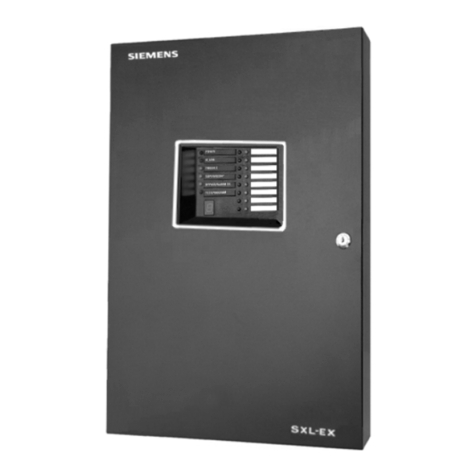
Siemens
Siemens SXL-EX Operation, installation, and maintenance manual
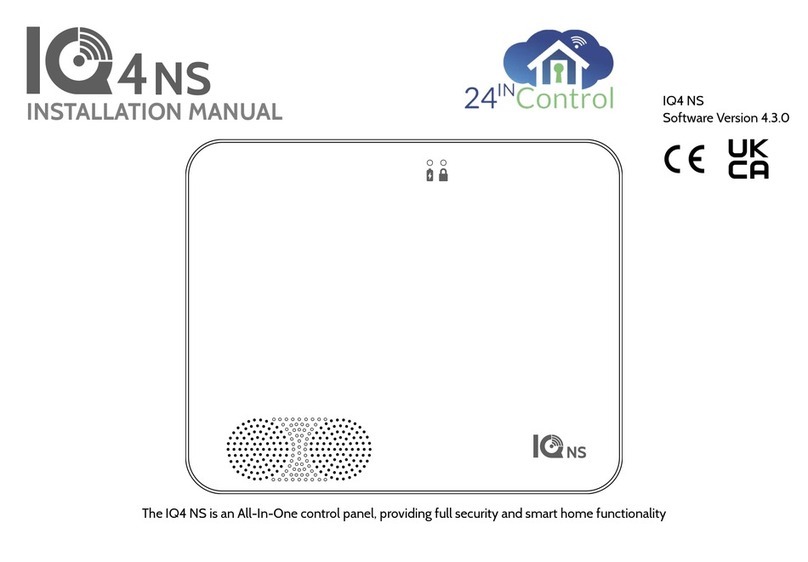
Johnson Controls
Johnson Controls IQ4 NS installation manual

Sonniger
Sonniger INTELLIGENT eco manual

Skutt
Skutt EasyView w/LinkBoard Service training manual
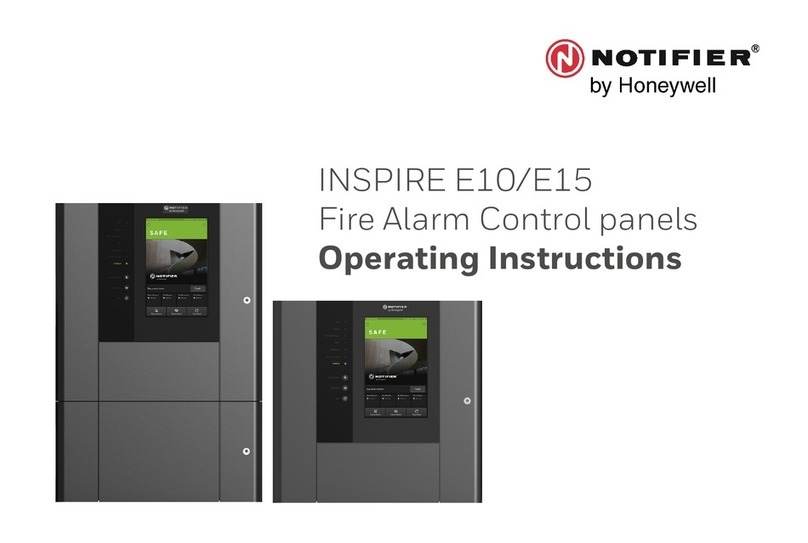
Honeywell
Honeywell NOTIFIER INSPIRE E10 operating instructions
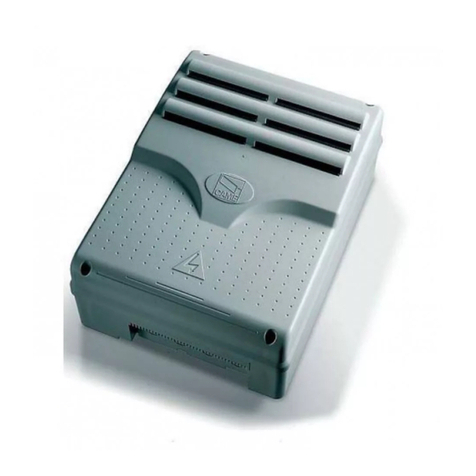
CAME
CAME zl92 installation manual
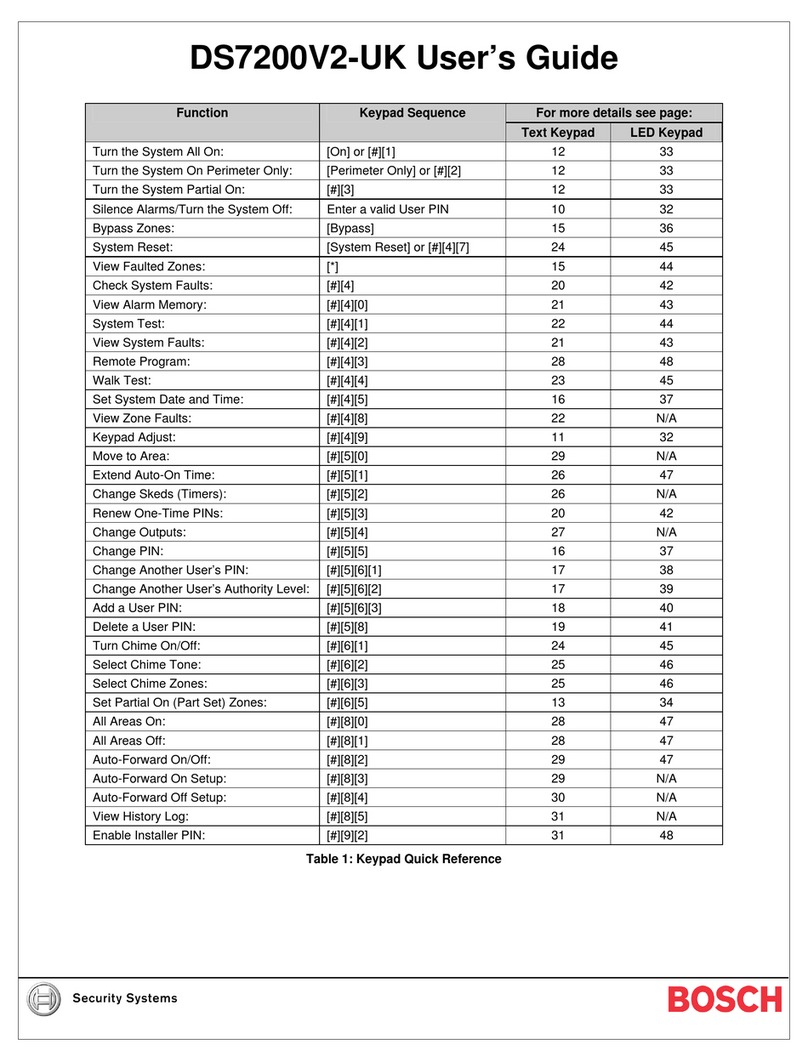
Bosch Security
Bosch Security DS7200V2-UK user guide
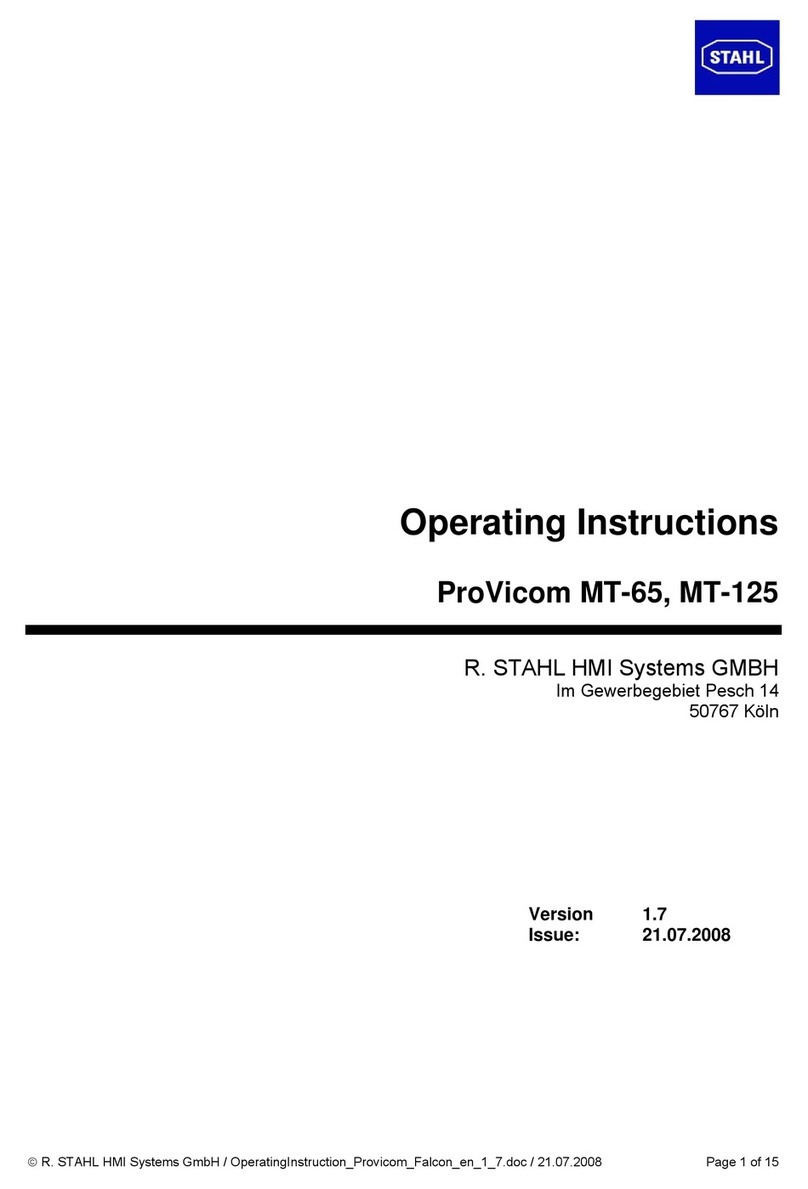
Stahl
Stahl ProVicom MT-65 operating instructions
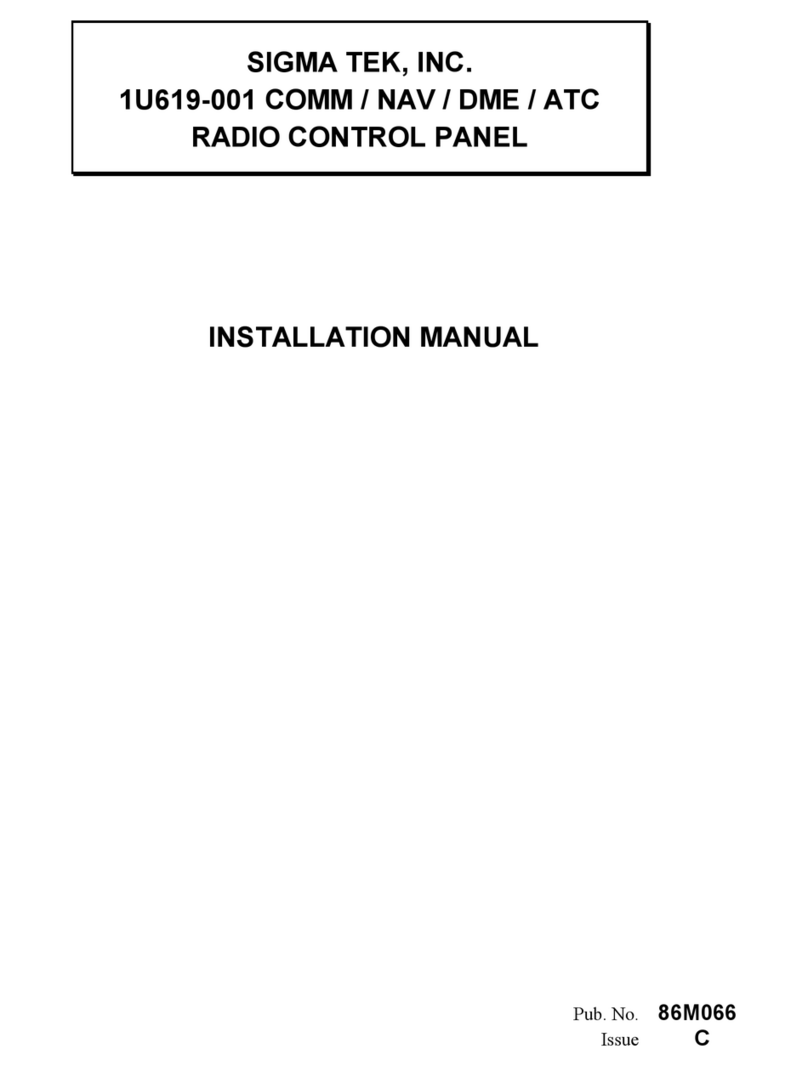
SIGMA TEK
SIGMA TEK 1U619-001 installation manual

NAPCO
NAPCO Gemini GEM-P9600 Programming instructions

C-TEC
C-TEC XFP510-32 installation manual
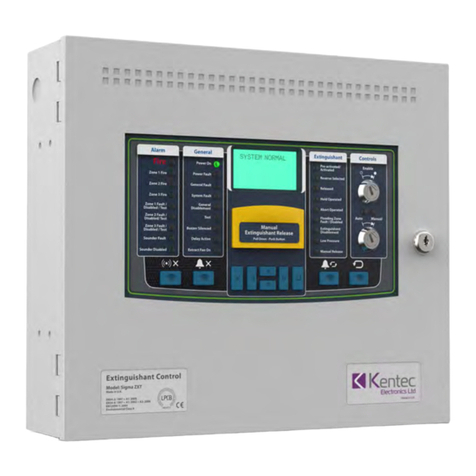
Kentec Electronics
Kentec Electronics Sigma ZXT installation manual
